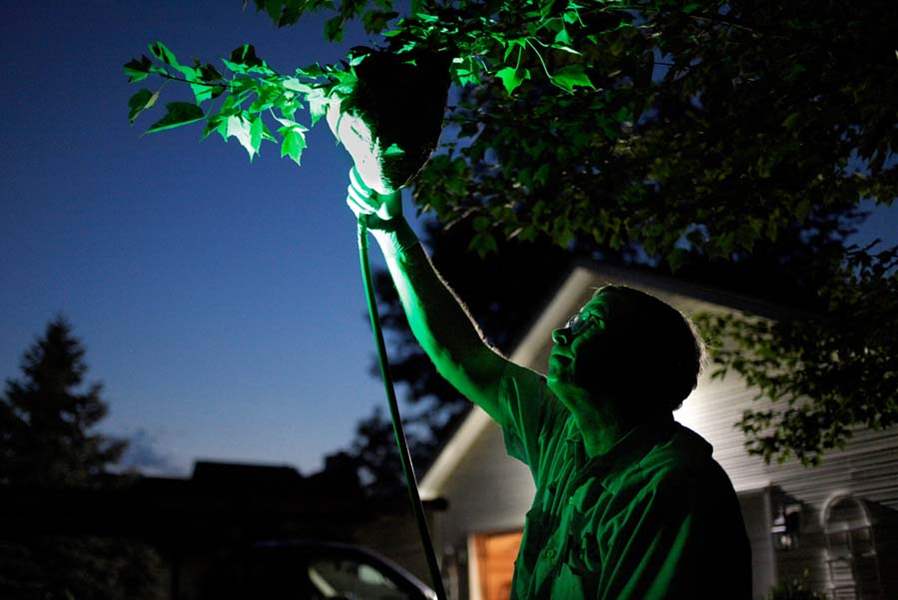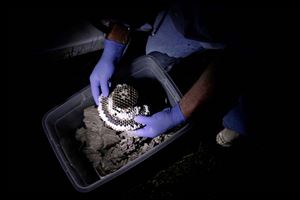
TOLEDO MAGAZINE
Risky Harvest: Entomologist collects hornet nests for vaccine
8/18/2013
Russell Lamp, owner of Integrated Pest Control, waits until dark to spray carbon dioxide in the next to temporarily knock out the hornets. The hornets are collected, froze, and shipped to pharmaceutical companies that extract venom for allergy vaccines.
THE BLADE/JEFFREY SMITH
Buy This Image

Russell Lamp, owner of Integrated Pest Control, waits until dark to spray carbon dioxide in the next to temporarily knock out the hornets. The hornets are collected, froze, and shipped to pharmaceutical companies that extract venom for allergy vaccines.
On many summer evenings, Russell Lamp isn’t necessarily looking for trouble when he tests that insect-based idiom and “stirs up a hornets’ nest”.
Searching out and collecting those papery piñatas filled with angry bugs is a familiar flirtation with danger for the veteran entomologist, who estimates that he has collected more than a couple thousand nests in the Toledo area over the past 30 years.
The risk is far out-distanced by the reward, since the end result of Lamp’s work is a vaccine that protects that small percentage of the human population that can experience a potentially fatal allergic reaction to the insect’s venom.
PHOTO GALLERY: Risky Harvest
Lamp, a pest control specialist based in Oregon, collects the nests of bald-faced hornets -- a wasp that builds those large, gray, paper lantern-like creations that are usually hanging from tree branches. After a meticulous cleaning and sorting process, Lamp sells the hornets to several pharmaceutical companies across the country, where the hornets become part of the vaccine process.
“Actually, collecting the nests might seem pretty dangerous, but it’s really the easiest part of the process,” said Lamp, who does not charge to remove nests that are located in northwest Ohio and nearby in southeast Michigan, and are at least as large as a basketball, relatively easy to access, and have not been sprayed.
OBJECT“It is the cleaning and sorting that make up the most work. And since these wasps deteriorate very quickly, you have to work fast.”
Lamp will arrive at the site just before dark, when the peak activity has slowed considerably and most of the hornets have returned to the nest. He uses carbon dioxide to temporarily stun the hornets and then quickly encloses the nest in a container before the gas wears off.
The nest is frozen, and then cleaned of debris as Lamp goes through the painstaking process of sorting and discarding the males. Since only the female hornets have venom, those are the only ones needed by the lab.
An average nest will have around 175 female hornets inside, but Lamp has cleaned some very large nests that held as many as 500. He uses dry ice to keep the insects cold during the cleaning and sorting process, and also ships the hornets packed in the material.
At the lab, technicians work in a sterile, low temperature environment and remove the stingers from each female hornet. A venom sack attached to the end of the stinger will hold a tiny amount of the potent material. The venom sacks are chopped, loaded into a centrifuge, and a buffering compound is added to preserve the mixture.
The material that results from the process is a desensitizing vaccine that will be used -- in minute, periodic doses -- to build up a resistance to severe allergic reactions in the roughly three percent of the population that is at risk of going into anaphylactic shock if stung.

Mr. Lamp loads a nest into a plastic tub to be taken back to the shop to be frozen.
When Lamp started gathering hornet nests in 1989, there were more than 500 collectors nationwide. Now there are around 20.
“The labs need quality, not quantity,” he said. "This is a program that saves lives, so everything has to be done by the book. It's very important that we get these nests when they are active and full, at this time of year, and that they be processed properly."
Lamp, who has removed about 100 bald-faced hornet nests so far this summer, has a background in working with honeybees, and is constantly educating his customers on the differences between bees, and hornets, which are actually wasps. In the scientific world, all hornets are considered wasps, but not all wasps are referred to as hornets.
"I hear them called ‘bees’, but these are not bees . Bees feed on nectar and pollen, while these hornets are meat-eaters that will feed on mosquitoes, flies, and other insects.”
Contact Blade outdoors editor
Matt Markey at: mmarkey@theblade.com or 419-724-6068 .